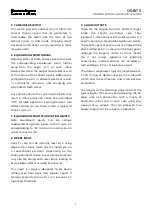
ORBIT 3
DOUBLE-SCROLL CHAOS OSCILLATOR
5
10 EQUILIBRIUM POINT OUTPUT
At each instance, this output represents the
equilibrium point that is currently being orbited.
The output voltage will alternate b5 V
for the positive scroll, and 0 V for the negative.
The resulting signal may be used as a pseudo-
random gate stream in low frequency mode, or
as a sound source at audio frequencies.
11 VOLT PER OCTAVE TRIMMER
This trim potentiometer is used to calibrate the
module’s pitch tracking. Since it is accessible
from the front panel, calibration can be easily
performed without removing the module from
the system. Each module is individually
calibrated during production; do not adjust this
trimmer if not needed.
Should you find your Orbit 3 to be out of tune, set
it to the audio frequency range and in wild mode,
with the coarse frequency knob to about 30 % of
its range (10 o’clock), the distribution knob to 9
o’clock, and the frequency modulation and both
equilibrium point position knobs fully clockwise.
There should now be a steady, regular oscillation
on all outputs. If not, you may need to adjust the
distribution or equilibrium point knobs slightly.
Make sure Orbit 3 has been powered for at least
20 minutes at a stable ambient temperature.
Now connect the equilibrium point output to a
calibrated digital tuner.
During the tuning process, the frequency
modulation input should be continually
switched between 0 V and a pre4 V
source, toggled automatically or by hand. Leave
all other inputs unpatched.
Using a dedicated trimming tool or standard
2.5 mm flat screwdriver, adjust the trimmer until
the interval between both states is exactly 4
octaves. For example, if 0 V corresponds to a
pitch of C1 + 23 cents, +4 V should yield C5 + 23
cents.

























